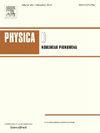Supercontinuum generation in a few-mode liquid-core fiber
IF 2.7
3区 数学
Q1 MATHEMATICS, APPLIED
引用次数: 0
Abstract
Liquid-core fibers have been widely used for supercontinuum generation because of the high nonlinearity and high transparency of selected liquids. These fibers are fabricated using silica capillaries with micrometer core diameters infiltrated with nonlinear liquids. Since nonlinear liquids typically have a refractive index much higher than silica, this results in multimode guidance, especially in large core fibers. This study focuses on numerically investigating supercontinuum generation in a few-mode liquid-core (-core) fiber by using a commercial femtosecond laser with a central wavelength of 1560 nm and a pulse duration of 100 fs. The fiber has a core diameter of and supports 24 polarized modes. Due to the high noninstantaneous nonlinearity of , the liquid-core fiber can achieve supercontinuum generation with higher coherence compared to solid-core fibers, for both linear and circular polarization. Additionally, this work investigates the interaction among the four polarized components of the first high-order mode (), pointing out the differences in power transfer between the polarized modes in the case of linear and circular polarization. The interaction between and modes with all existing modes is also discussed.
少模液芯光纤中超连续谱的产生
由于所选液体的高非线性和高透明度,液芯光纤被广泛用于超连续介质的产生。这些纤维是由芯径为微米的二氧化硅毛细管与非线性液体渗透制成的。由于非线性液体通常具有比二氧化硅高得多的折射率,这导致了多模制导,特别是在大芯光纤中。本文利用中心波长为1560 nm、脉冲持续时间为100 fs的商用飞秒激光器,对低模液芯(cs2芯)光纤中超连续谱的产生进行了数值研究。光纤芯径为5μm,支持24种偏振模式。由于CS2的高度非瞬时非线性,液芯光纤在线偏振和圆偏振下都能产生比固芯光纤更高相干度的超连续谱。此外,本研究还研究了第一阶高阶模式(LP11)的四个极化分量之间的相互作用,指出了线偏振和圆偏振情况下极化模式之间功率传输的差异。讨论了HE11、x和TM01模式与所有现有模式的相互作用。
本文章由计算机程序翻译,如有差异,请以英文原文为准。
求助全文
约1分钟内获得全文
求助全文
来源期刊

Physica D: Nonlinear Phenomena
物理-物理:数学物理
CiteScore
7.30
自引率
7.50%
发文量
213
审稿时长
65 days
期刊介绍:
Physica D (Nonlinear Phenomena) publishes research and review articles reporting on experimental and theoretical works, techniques and ideas that advance the understanding of nonlinear phenomena. Topics encompass wave motion in physical, chemical and biological systems; physical or biological phenomena governed by nonlinear field equations, including hydrodynamics and turbulence; pattern formation and cooperative phenomena; instability, bifurcations, chaos, and space-time disorder; integrable/Hamiltonian systems; asymptotic analysis and, more generally, mathematical methods for nonlinear systems.
 求助内容:
求助内容: 应助结果提醒方式:
应助结果提醒方式:


